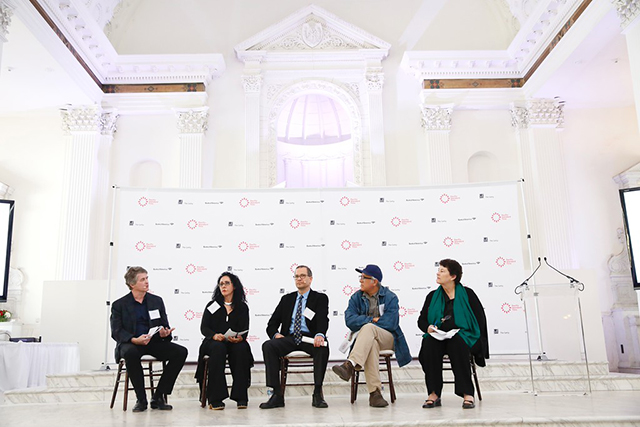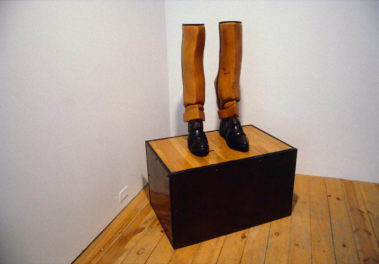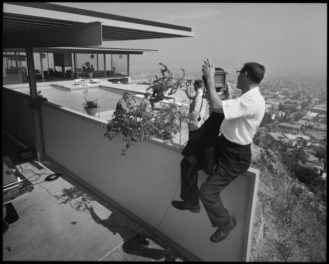
Curator Dan Cameron, art historian and curator Cecilia Fajardo-Hill, UCLA Chicano Studies professor Chon Noriega, artist Rubén Ortiz Torres, and Getty Foundation director Deborah Marrow speak during the press conference for Pacific Standard Time: LA/LA held at Vibiana on March 30, 2016. Photo: Ryan Miller/Capture Imaging
On March 30 more than 250 members of L.A.’s arts community—museum directors, curators, community partners, press, the mayor, and members of the Getty staff—gathered at historic Vibiana in Downtown Los Angeles to celebrate the next phase of Pacific Standard Time: LA/LA. This initiative, launching in September 2017, will include exhibitions and programs highlighting different aspects of Latin American and Latino art from the ancient world to the present.
The event included a panel discussion with curators Chon Noriega, Dan Cameron, Cecilia Fajardo-Hill, Rubén Ortiz Torres, and Getty Foundation director Deborah Marrow. Panelists discussed what the initiative means for the future of Latin American and Latino scholarship and for Los Angeles itself.
Here are a few insights and exciting details from that discussion about what’s in store for 2017:
- #PSTLALA will include 43 organizations. Forty-three arts organizations from Santa Barbara to San Diego, and from Los Angeles and Orange County to Palm Springs, will present exhibitions and programs on dozens of topics that have been researched and planned with the aid of the Getty Foundation’s grantmaking. The recently announced $8.45 million in new grants brings the Foundation’s total support to $14 million to date.
- The collaboration is beyond borders. The original research required for Pacific Standard Time: LA/LA programs led to international partnerships and cooperation among scholars, artists, and critics across the United States, Latin America, and Europe. Deborah Marrow noted that “the point isn’t to tell one comprehensive story—there are simply too many places, time periods, types of art—but there will be many, many interesting and new stories that emanate from the research that has been done.”
- It reflects the diversity of Southern California. Mayor Eric Garcetti reflected that Los Angeles isn’t your typical city. It does not have one strong center, but rather is formed of diverse, immigrant communities knitted together over an emphatically horizontal space. What better place, then, to take up a project that covers this much ground—artists from three different continents and dozens of countries across hundreds of years.

Limitada, 1978, Marie Orensanz. Photograph, edition 1 of 5, 13 3/4 x 19 11/16 in. Courtesy and © the artist
- Marginalized voices will be heard. Cecilia Fajardo-Hill, co-curator of the upcoming Hammer Museum exhibition Radical Women: Latin American Art, 1960–1985, noted in the panel discussion that while women artists from Latin America and those of Latina and Chicana descent were producing pioneering work in often harsh political and social environments, many did not receive the respect and renown accorded to their male peers. The exhibition will feature works by more than 100 artists from 15 countries, including work by Lygia Clark, Ana Mendieta, and Marie Orensanz, whose radical and influential artwork is ripe for rediscovery.

Livia Corona Benjamin, Ten Thousand Three Hundred Square Feet Homes. Fraccionamiento Los Encinos, Ensenada, Mexico, 2009, Livia Corona Benjamin. CPrint, 30 x 40 in. © Livia Corona Benjamin
- Exhibitions will join known and emerging artists. Co-curator Chon Noriega uses the simple idea of “home” as a powerful lens through which to view profound socioeconomic and political transformations in the western hemisphere in Home—So Different, So Appealing, an exhibition produced by the UCLA Chicano Studies Research Center in partnership with the Museum of Fine Arts, Houston, and exhibited at the Los Angeles County Museum of Art (LACMA). The work of internationally recognized artists will be exhibited alongside the work of lesser-known artists, all united in their alternative narratives of postwar and contemporary art and by their wide range of media, often including material from actual homes.

Kinncchromatic Object, 1969/1986, Julio LeParc. Metal, wood, motor, gears. © Abraham Palatnik
- A more complete art history will emerge. Even before Southern California became the epicenter of Light and Space art in the 1960s, radical work in this area was being created by artists in Argentina and Venezuela, including Jesús Rafael Soto, Julio Le Parc, Carlos Cruz-Diez, and Martha Boto. Curator Dan Cameron discussed these artists in relation to Kinesthesia: Latin American Kinetic Art, 1954–1969, an exhibition opening at the Palm Springs Art Museum. The exhibition will tell the stories of kinetic art in Latin America through 50 works that demonstrate the artists’ daring experimentation that preceded many of their North American counterparts.

Minnie/Che, 2003, Liliana Porter. Archival digital print, 4’ x 3’ x 4’, 2011. Courtesy of and © Liliana Porter
- Even Disney is in the mix. The MAK Center will present the exhibition How to Read El Pato Pascual: Disney’s Latin America and Latin America’s Disney. Exhibition co-curator Rubén Ortiz Torres noted that Disney’s relationship with Latin America has been fraught, but has also yielded art that responds to, plays with, re-appropriates, and misappropriates Disney’s iconography. He illustrated this with an image of Pato Pascual (Donald Duck), the emblem of Pascual Boing, a Mexican soft drink maker that has been run as a workers’ cooperative since 1985.

Nose Ornament with Spiders, Salinar culture, 1st century BCE–2nd century CE. The Metropolitan Museum of Art, The Michael C. Rockefeller Memorial Collection, Bequest of Nelson A. Rockefeller, 1979 (1979.206.1172) Image © The Metropolitan Museum of Art
- The Getty will have some of the oldest and newest art. The Getty will have four exhibitions related to Pacific Standard Time that span over one thousand years, including luxury arts of the pre-Columbian Americas, postwar abstraction in Argentina and Brazil, a comprehensive history of Argentine photography, and an examination of Latin American cityscapes over time.
For more information about Pacific Standard Time: LA/LA, visit pacificstandardtime.org.




Comments on this post are now closed.